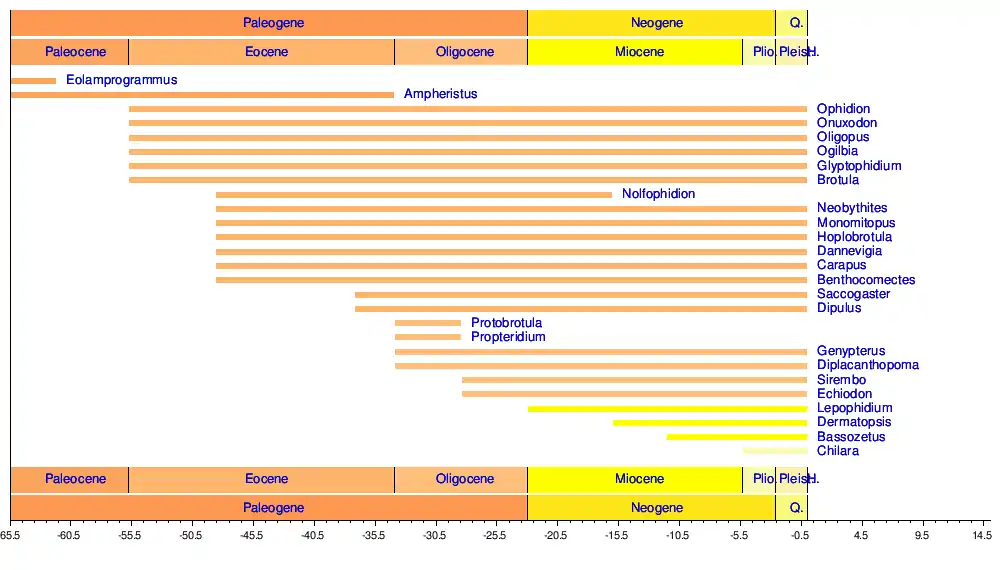| Ophidiiformes Temporal range: | |
|---|---|
 | |
| Fawn cusk-eel, Lepophidium profundorum | |
| Scientific classification | |
| Domain: | Eukaryota |
| Kingdom: | Animalia |
| Phylum: | Chordata |
| Class: | Actinopterygii |
| Clade: | Percomorpha |
| Order: | Ophidiiformes L. S. Berg, 1937 |
| Type species | |
| Ophidion barbatum Linnaeus 1758 | |
| Suborders | |
|
See text | |
Ophidiiformes /ɒˈfɪdi.ɪfɔːrmiːz/ is an order of ray-finned fish that includes the cusk-eels (family Ophidiidae), pearlfishes (family Carapidae), viviparous brotulas (family Bythitidae), and others. Members of this order have small heads and long slender bodies. They have either smooth scales or no scales, a long dorsal fin and an anal fin that typically runs into the caudal fin. They mostly come from the tropics and subtropics, and live in both freshwater and marine habitats, including abyssal depths. They have adopted a range of feeding methods and lifestyles, including parasitism. The majority are egg-laying, but some are viviparous.
The earliest fossil member is Pastorius from the Maastrichtian of Italy.[1][2]
Distribution
This order includes a variety of deep-sea species, including the deepest known, Abyssobrotula galatheae, found at 8,370 metres (27,460 ft) in the Puerto Rico Trench. Many other species, however, live in shallow water, especially near coral reefs, while a few inhabit freshwater. Most species live in tropical or subtropical habitats, but some species are known from as far north as the coast of Greenland, and as far south as the Weddell Sea.[3]
Characteristics
Ophidiiform fish typically have slender bodies with small heads, and either smooth scales, or none at all. They have long dorsal fins, and an anal fin that is typically united with the caudal fin. The group includes pelagic, benthic, and even parasitic species, although all have a similar body form. Some species are viviparous, giving birth to live young, rather than laying eggs. They range in size from Grammanoides opisthodon which measures just 5 centimetres (2.0 in) in length, to Lamprogrammus shcherbachevi at 2 metres (6.6 ft) in length.[3]
The families Ranicipitidae (tadpole cods) and Euclichthyidae (eucla cods) were formerly classified in this order, but are now preferred in Gadiformes; Ranicipitidae has been absorbed within the family Gadidae.
Timeline of genera

Classification
The order Ophidiiformes is subdivided into suborders and families as follows:[4]
- Suborder Ophidioidei
- Family Carapidae Poey, 1867 — pearlfishes
- Family Ophidiidae Rafinesque, 1810— cusk-eels
- Suborder Bythitoidei
- Family Bythitidae Gill, 1861 — viviparous brotulas
- Family Aphyonidae Jordan & Evermann, 1898 — aphyonids, blind cusk-eel
- Family Parabrotulidae Nielsen, 1968 — false brotulas
The suborder Ophidioidei may be a paraphyletic grouping but the suborder Bythitoidei are viviparous and seem to make up a monophyletic clade,[5] while the Ophidioidei are oviparous.[6]
References
- ↑ Carnevale, Giorgio; Johnson, G. David (2015). "A Cretaceous Cusk-Eel (Teleostei, Ophidiiformes) from Italy and the Mesozoic Diversification of Percomorph Fishes". Copeia. 103 (4): 771–791. doi:10.1643/CI-15-236. ISSN 0045-8511.
- ↑ Friedman, Matt; V. Andrews, James; Saad, Hadeel; El-Sayed, Sanaa (2023-06-16). "The Cretaceous–Paleogene transition in spiny-rayed fishes: surveying "Patterson's Gap" in the acanthomorph skeletal record André Dumont medalist lecture 2018". Geologica Belgica. doi:10.20341/gb.2023.002. ISSN 1374-8505.
- 1 2 Nielsen, Jørgen G. (1998). Paxton, J.R.; Eschmeyer, W.N. (eds.). Encyclopedia of Fishes. San Diego: Academic Press. pp. 133–134. ISBN 0-12-547665-5.
- ↑ Nelson, JS; Grande, TC & Wilson, MVH (2016). "Classification of fishes from Fishes of the World 5th Edition" (PDF). Retrieved 10 June 2018.
- ↑ Jørgen G. Nielsen; Daniel M. Cohen; Douglas F. Markle & C. Richard Robins (1999). FAO Species Catalogue Volume 18 Ophidiiform Fishes of the World (Order Ophidiiformes) An annotated and illustrated catalogue of pearlfishes, cusk-eels, brotulas and other ophidiiform fishes known to date. Food and Agriculture Organization of the United Nations, Rome. p. 3. ISBN 9251043752.
- ↑ Daniel M. Cohen & Jørgen G. Nielsen (1978). NOAA Technical Report NMFS Circular 417 Guide to the Identification of Genera of the Fish Order Ophidiiformes With a Tentative Classification of the Order (PDF). National Oceanic and Atmospheric Administration/National Marine Fisheries Service. p. 6. Retrieved 30 June 2018.
- Froese, Rainer, and Daniel Pauly, eds. (2006). "Ophidiiformes" in FishBase. February 2006 version.
- "Ophidiiformes". Integrated Taxonomic Information System. Retrieved June 23, 2005.
- Sepkoski, Jack (2002). "A compendium of fossil marine animal genera". Bulletins of American Paleontology. 364: 560. Retrieved 2011-05-17.